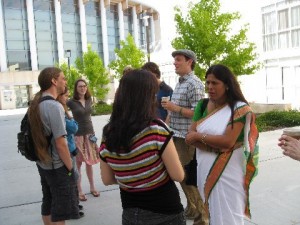New format at NASK after 40 years Posted by Chuck Smith on Jan 25, 2011 in Esperanto Culture, Events
Today, I have Ellen Eddy with me who runs the North American Summer Esperanto Institute (in Esperanto: Nord-Amerika Somera Kursaro, NASK) which is an Esperanto course always run at an American university where people come from around the world to learn Esperanto intensively for a few weeks. I actually attended it myself in Brattleboro, Vermont back in 2004 when they offered training for Esperanto teachers. This year, they’re experimenting with changing the format and I’m excited to find out what’s new.
How did NASK get started?
NASK started in San Francisco in 1970 after Bill and Cathy Schulze convinced the regents of San Francisco State University that it was a viable course to add to their summer sessions. What was its original purpose? The original purpose was to train teachers in how to teach Esperanto and to raise the language capability of U. S. speakers of Esperanto. Before NASK a person would have to go to Europe to get such training.
When and where does it take place?
This year for the fifth time the classes will be at the University of California, San Diego. The students will be housed together in the International House of the Eleanor Roosevelt College. Students arrive on July 2 and leave on July 10.
What is a typical day like for someone attending NASK?
After getting dressed, students walk to the nearby Cafe Ventanas for breakfast. Afterwards, they head to class which starts at 8:30. Classes continue until 12:30 with a short break around mid-morning. Lunch is from 12:45 until 13:30. Afternoons vary. There can be short learning sessions, games, trips to nearby places of interest (especially the beach which is within walking distance), special presentations by teachers or students. Dinner is at 17:30 to 19:00. Evenings are filled with special programs planned by the students and/or instructors. We try to leave some time for homework, too.
Who will be teaching this year?
Birke Dockhorn from Germany, Bertilo Wennergren from Sweden and Lee Miller from the US. This is the third time this group has worked as a team. Students in the past were particularly happy to ask Bertilo grammer questions as he is the author of the popular PMEG (Plena Manlibro de Esperanta Gramatiko, Complete Handbook of Esperanto Grammar).
Why did you decide to change the format?
We were finding more potential students saying that they didn’t have three weeks of vacation time or/and as much money as needed for the typical NASK. Also the economy and job situation in the US has suffered so much and the prices at the university are still going up. We thought it was time to try a new format. Using the 4th of July holiday allows us to plan an intensive 9 day program which uses only 4 vacation days and of course doesn’t cost as much. Students will be studying everyday, even on the holidays.
How much does it cost?
Before March 15, the general cost for housing with three meals a day and tuition is US$865 (635 €) with a special price of US$665 (488 €) for full time students and those from Latin America. After March 15th, the price is $895 (657 €) and $695 (510 €).
Are there scholarships available? If so, how can you find out about them?
There is some scholarship help available. Those who would like to inquire can contact me at eddyellen@aol.com.
What would you say to someone who is now sitting on the fence, not sure if they want to attend NASK?
This is a great chance to experience NASK and be immersed in Esperantio on a budget.
Thank you so much for everything. Visit the NASK website for more details!

Build vocabulary, practice pronunciation, and more with Transparent Language Online. Available anytime, anywhere, on any device.
About the Author: Chuck Smith
I was born in the US, but Esperanto has led me all over the world. I started teaching myself Esperanto on a whim in 2001, not knowing how it would change my life. The timing couldn’t have been better; around that same time I discovered Wikipedia in it’s very early stages and launched the Esperanto version. When I decided to backpack through Europe, I found Esperanto speakers to host me. These connections led me to the Esperanto Youth Organization in Rotterdam, where I worked for a year, using Esperanto as my primary language. Though in recent years I’ve moved on to other endeavors like iOS development, I remain deeply engrained in the Esperanto community, and love keeping you informed of the latest news. The best thing that came from learning Esperanto has been the opportunity to connect with fellow speakers around the globe, so feel free to join in the conversation with a comment! I am now the founder and CTO of the social app Amikumu.






